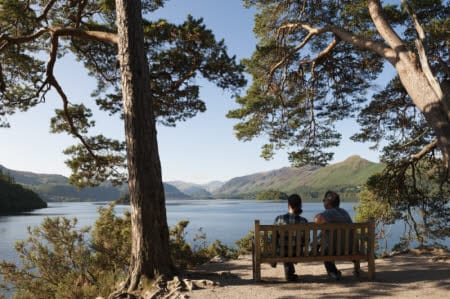National Trust Celebrates 100th Anniversary Of Friar's Crag Donation
Friar’s Crag, beloved for its unbroken views across Derwent Water and towards the ‘jaws’ of Borrowdale, has long been a popular spot with visitors to the area. The 12th February saw the National Trust celebrating the 100th anniversary of Friar’s Crag being in its care – marking the rich history and connection the viewpoint has to the very beginnings of the Trust.
The crag was purchased with money raised in public subscription to the memory of Canon Hardwicke Rawnsley (1851-1920), one of the three principal founders of the National Trust, and donated to the charity in his name on this day in 1922. In a grove of trees on the crag lives a slate memorial to the writer, thinker and painter John Ruskin – a lifelong friend and influential figure in Hardwicke's life – who named the view as his earliest memory:
“The first thing I remember was... being taken by my nurse to the brow of Friar's Crag.”
Hardwicke Rawnsley had a passionate devotion to protecting land from development, a belief in preserving the natural landscape for everyone to enjoy that is as important today as it was over 125 years ago, when he helped to found the National Trust – along with Octavia Hill and Sir Robert Hunter.
As vicar at St Kentigern’s, Crosthwaite, on the outskirts of Keswick, he was an active parish priest, described by a parishioner as “the most active volcano in Europe”. He became a prominent national figure after campaigning against proposed railways that threatened to spoil the natural beauty of the Lakes and, in doing so, demonstrating the importance of the landscape and its effects on the human spirit.
It’s said that it was his association with John Ruskin at Balliol College, Oxford which altered his course and awakened his social conscience. It was a decade later that he became known for defeating the parliamentary Bill proposing a Honister-to-Braithwaite railway line and then establishing the Lake District Defence Society, continuing in its mission of protecting the area, as well as preserving rights of way and access to commons land. He was also instrumental in the ‘Mass Trespass’ to Latrigg and round Derwentwater, helping to establish legal precedent for our network of public footpaths across the country.
National Trust ranger Roy Henderson comments: “It’s so inspiring that Rawnsley’s legacy is still reflected in the work of the Trust to this day. His campaigning activity to preserve the Lake District for everyone for ever translates today into our efforts to mitigate the challenges we see – such as climate change, tree disease – as well as ensuring we’re protect the places and spaces we love.”
Rawnsley was particularly passionate about the integral role of the landscape of the Lake District within the nation’s literary heritage – recognising what the landscape meant to the Wordsworths, Samuel Taylor Coleridge and Robert Southey.
This week sees the Cumbria Dark Skies Festival launch, with Friar’s Crag being a popular star-gazing spot. It feels fitting that over a century on, visitors are continuing to enjoy this preserved place and enjoy the connection to the land that Rawnsley campaigned so fervently for.

